what features can be used to interpret which way a prehistoric fault moved?

Introduction to Physical Geology |
Chapter 6 - Faults, Earthquakes, and Landscapes
| Earthquakes occur somewhere around the earth, every hr of every day. Most are too minor to fifty-fifty feel—however, large-magnitude, damaging earthquakes happen somewhere around the globe nigh every year. Big earthquakes in unprepared regions can crusade widespread chaos, destruction, and expiry. Earthquakes are associated with faults, only not all faults currently generate earthquakes (they may have been active long ago). Faults range is size from small fractures in a local outcrop to great fault systems that tin can extend for thousands of miles. Fault systems evolve and change over time—driven past plate tectonic forces associated mantle convection influencing the rigid lithosphere. Mistake systems are frequently associated with volcanic regions. Faults may form and remain active for long ages before becoming inactive, and then may get reactivated again in some later on period. Tectonic forces within the World deform rocks through processes of folding and faulting, producing many of the landscape features observable around us. This affiliate focuses of the examination of faults, their geometry, and how they appear on the natural landscape. It as well includes information about earthquakes, convulsion prediction, and convulsion preparedness. Plate tectonics and the internal structure of the Globe are discussed in Chapter vi. | Click on thumbnail images for a larger view. |
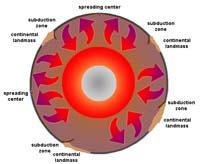 Fig. 6-one. Gravitational rut convection in the curtain is the driving forcefulness of movement in the Globe'south lithosphere. |
What causes of deformation in the Globe's lithosphere? (An Overview)Deformation is the action or process of changing in shape or distorting, especially through the awarding of pressure. In geologic terms, deformation refers to changes in the Earth's lithosphere related to tectonic activity, particularly folding and faulting (discussed below).The term lithosphere is used to draw the World's rigid outer layers that include the brittle, rocky crust and underlying upper function of the mantle.Heat from deep inside the Earth drives gravitational heat convection (hot material expands and rises, cool denser fabric sinks, Figures half-dozen-1 and half-dozen-2). The rise and autumn of masses of fabric in the mantle create forces that move the rocks in the cool and breakable lithosphere most the Earth'due south surface. These motions exert great forces, potent enough to rip continents apart, but the charge per unit of movement is mostly extremely slow on an annual basis. Motion inside the upper mantle (asthenosphere) is responsible for deep crustal stretching (extension) and compression in the overlying lithosphere. Whereas the fluid-similar country of rocks in the asthenosphere motility slowly, the solid, breakable material in the lithosphere builds up cracking pressure (stresses) and the rocks will strain nether the pressure until the point that they may rupture quickly, causing earthquakes that propagates equally a shock waves through the Earth. Isostasy Similarly, the crust is always readjusting to changing forces from both to a higher place and below. If a section of lithosphere is reduced in mass, as by erosion, it will slowly ascent to a new equilibrium position (Figure 6-5). On land, erosion strips away material over time, and isostasy causes the crust to ascension. The sediment deposited along continental margins, increases the rock mass, and causes the crust along continental margins to sink. |
Igneous Activeness Can Crusade Crustal Deformation
Heat rising from the mantle can cause rocks to expand, causing them to loose density and rise. In improver molten material derived from the lower crust and mantle is typically under swell force per unit area, and can force its mode through fractures and zones of weakness. Migrating magma displaces and deforms rocks equally the molten material forces its fashion upwards, frequently filling airship-like magma chambers deep in the subsurface. Information technology will also displace or deform rocks while forcing its way toward the surface to create volcanoes. Massive volcanic eruptions are associated with faulting and normally occur in association with intense convulsion activity. Massive asteroid impacts that occurred throughout Earth history have also caused massive local and regional deformation, shattering and melting rocks from stupor waves associated caused by their impact. Types of FoldsAll kinds of rocks are subject to deformation forces, but the effects are most piece of cake to observe in stratified rocks that originally accumulated every bit apartment layers (sedimentary layers or volcanic lava flows and ash deposits). A geological fold occurs when one layer or a stack of originally flat and planar surfaces are bent or curved as a result of permanent deformation. Folding is the bending or warping of stratified rocks by tectonic forces (movements in the Earth'southward crust). Folds can be observed on many scales , for tiny folds as can be seen in hand specimens, to larger scales equally can be seen on the sides of road cuts or canyons, or very large scale such every bit entire mountain ranges to features that are so large they can only exist seen from airplanes or satellites. Folds typically accept a linear orientation that has a defined axis, like to the orientation of the crest of a roof line or a trough of a gutter.Figure 6-6 illustrates different types of folds.An anticline is a fold in layers of rock (strata) where the concave side faces down, with strata sloping down on both sides from a common crest [axis] (Effigy 6-6).A syncline is a trough-shaped fold of stratified rock in which the strata slope up from the axis; opposite of an anticline (Effigy six-7). Plunging folds are folds (anticlines or synclines) that are tipped past tectonic forces and have a swivel line not horizontal in the centric plane (Figures half dozen-ix to 6-ten). A dome is a deformational characteristic consisting of symmetrically-dipping anticlines; their general outline on a geologic map is circular or oval (Figures 6-eleven to 6-12). | 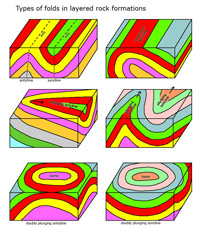 Fig. 6-half-dozen. Folds illustrated with block diagrams: anticline, syncline, an overturned fold, a plunging syncline, plunging anticline and syncline, a dome, and a basin. 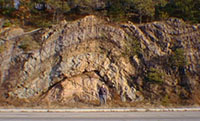 Fig. 6-6. An anticline and syncline exposed in a route cut along Road 23 almost the town of Butler in northern New Jersey. Strata displaying anticlinal fold arch upwards in the middle; a syncline forms a smile-like trough. |
How are structural features described and illustrated on maps and cross sections?Geologists use the terms strike and dip to describe the orientation of layers of stratified rocks exposed at the world surface ( 6-xv). Strike and dip are well illustrated by the Strike Valley in Capitol Reef National Park in Utah (Figure 6-16).Strike is the direction taken past a structural surface, such as a layer of rock or a fault aeroplane, equally it intersects the horizontal. Strike is measured in degrees eastward or w of truthful north.Dip is the bending that a rock layer or any planar feature makes with the horizontal, measured perpendicular to the strike and in a vertical plane. Dip angles can range from 0 (zero) degrees for horizontal beds, to 90° for vertically inclined beds, or college numbers upward to 180° for beds that are completely overturned. Describing strike and dip: The strike and dip of a bed might be written with strike designation before dip. Examples: N35°W, 15°W or N22°E, eighteen° E. Note that the dip direction is contingent on strike, and the W or E for the dip direction only depict if the beds are incline downward in a westerly or easterly management. Note, if the beds are horizontal, there is no strike and dip designation! Strike and dip measurement are illustrated on geologic maps using lines, arrows, and special T-shaped dip symbols (Figures 6-17). Figure half dozen-18 uses block diagrams to illustrated common map symbols used on geologic maps including different kinds of folds and faults. |
Rocks Shattered and Cleaved By Tectonic Forces
Joints - Fractures In RocksMany types of rocks are very brittle and will shatter (like glass) if subjected to pressure or a stupor wave from an convulsion, producing fractures. Erstwhile rocks exposed in mountainous regions typically appear shattered with fractures running in many directions. Sometimes at that place is a ascendant fracture direction or orientation pattern.A simple crack in a rock that displays no apparent start is called a articulation. A joint is a fracture in rock where the displacement associated with the opening of the fracture is greater than the deportation due to move in the plane of the fracture (upward, down or sideways) of i side relative to the other. If a fracture does not have obvious start it is a articulation. If a fracture displays starting time it is a fault (Figures 6-19 and 6-20 testify examples of joints). | 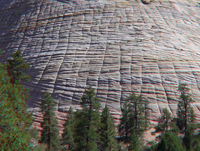 Fig. half-dozen-19. Joints in sandstone Checkerboard Mesa Zion National Park, Utah | 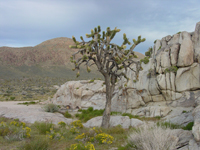 Fig. 6-twenty. Joints in granite Joshua Tree National Park, California |
Features Associated With FaultsA mistake is a fracture or cleft along which two blocks of stone slide past ane another. This movement may occur quickly, in the form of an earthquake, or slowly, in the form of creep (Effigy vi-20). Types of faults include strike-slip faults, normal faults, reverse faults, thrust faults, and oblique-slip faults. Faults tin can exist modest to large complex systems of interlinking faults and may change form one kind of fault in one location to some other kind somewhere else. Many faults are associated with folds. Faults split, bifurcate, merge, or tin can peter out over distances, sometime forming circuitous systems of fractures.The relative motion of faults (1 side to the other) is described in terms of relationship of a hanging wall and human foot wall (see normal mistake and reverse mistake examples in Figure half-dozen-20). A foot wall is the underlying block of a fault having an inclined fault plane. A hanging wall is the block (rocks) on the upper side of an inclined fault plane. Simply described here—if a fault is exposed well enough to see that the mistake airplane is inclined, the side you lot could stand on is called the foot wall. The side you could hang from without your feet touching the ground is the hanging wall. | 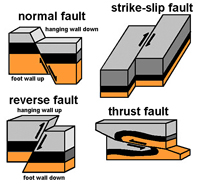 Fig. 6-20. Cake diagrams illustrating common types of faults: normal fault, reverse mistake, strike-slip mistake, and thrust fault. Offset strata illustrates the relative motion of the foot wall to the hanging wall of each type of fault. Fig. 6-20. Cake diagrams illustrating common types of faults: normal fault, reverse mistake, strike-slip mistake, and thrust fault. Offset strata illustrates the relative motion of the foot wall to the hanging wall of each type of fault. |
Types of Faults
At that place are iii types of dip-slip faults: normal , reverse , and thrust (Figure 6-21). The character of the motion (offset) along the fracture airplane determines what kind of dip-slip fault information technology is. If the rock mass above an inclined fault moves downwardly, the mistake is termed normal , whereas if the stone to a higher place the fault moves upward, the error is termed contrary . A opposite error in which the mistake plane is inclined at an angle equal to or less than 45° is called a thrust fault .
A normal mistake is a mistake in which the hanging wall appears to have moved down relative to the foot wall. The dip bending of the slip surface is between 45 and 90 degrees. Many normal faults in mountainous regions course from gravitational pull along mountainsides and may be associated with the headwall escarpment of slumps (examples: Figures half dozen-22 and 6-23).
A opposite mistake is a fault in which the hanging wall has moved up relative to the foot wall (case: Effigy six-24).
A thrust fault is a fault with a dip angle of 45º or less over its extent on which the hanging wall appears to take moved upward relative to the foot wall (example: Figure 6-25). Horizontal compression or rotational shear is responsible for displacement. (See also opposite error and oblique-slip error.)
A strike-slip error is a generally vertical fault along which the two sides move horizontally past each other (examples: Figures vi-26 and six-27). If the block opposite an observer looking across the fault moves to the right, the slip style is termed "right lateral." If the cake moves to the left, the motion is termed "left lateral." California's San Andreas Fault is the virtually famous example of a right-lateral strike-slip error. Strike-sideslip faults produce produce a variety of landforms including shutter ridges, pull-apart basins, sag ponds, and deflected streams.
Oblique-slip faults are faults that display meaning components of both horizontal (strike-slip) and vertical (dip-slip) move. An oblique-slip error combines strike-skid motility with significant normal, reverse, or thrust offset.
Descriptions of Fault CharacteristicsGeologists will first describe the kind of fault (normal, reverse, thrust, strike-slip, etc. encounter Figure 6-20). Strike and dip is too used to describe the orientation of fault surfaces and use special symbols to describe them on a map (run into Figure 6-18). Small arrows are commonly used to signal relative beginning motion along a fault on an illustration or map. Geologist also use selected terms to draw faults equally they appear on the land surface :A fault line is the intersection of a well-defined fault plane with the land surface. A mistake is typically illustrated as a line on a map. A fault zone is an area of many closely spaced faults and fractures that collectively can be mapped within a continuous zone. At that place may exist more than one fault line in a fault zone! (Figure half dozen-28). | 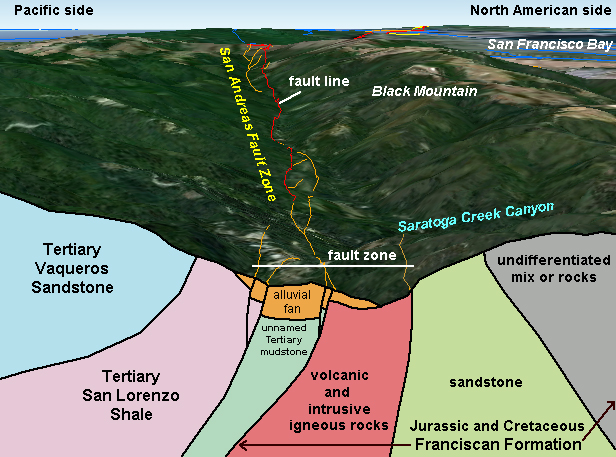 Fig. 6-28. Fault line and error zone illustrated for the San Andreas Fault in the Santa Cruz Mountains about San Jose, California. The San Andreas Error is part of the greater California Fault System which consists of numerous parallel and intersecting faults beyond the region. |  Fig. vi-29. The California Error System shown on a generalized geologic map in California |
Stress and StrainThe terms stress and strain are terms commonly used in mechanical engineering, only are also practical terms for describing the behavior of earth materials subjected to tectonic forces. Stress is the force acting on a rock or another solid to deform it, measured in kilograms per square centimeter or pounds per square inch. Strain Crustal Compression vs. Crustal TensionOn a regional calibration, rocks are subjected to stress that may exist compressional (such as along a convergent plate purlieus) or tensional (such as forth a rift valley or a spreading center of a divergent plate boundary). The faults in the vicinity of these stress forces produce faults and features that can exist described every bit crustal shortening or crustal extension (Figure half-dozen-thirty). Crustal compression is more probable to form thrust faults and reverse faults associated with crustal shortening, and crustal compression is typically associated with regions where mount ranges are being pushed up. In contrast, crustal tension is more likely to form normal faults associated with crustal extension. Continental rifting and associated crustal thinning are associated with crustal extension.Shearing stress is a forcefulness that occurs where opposing sides of a zone within the crust move in opposite directions, resulting in rotational bending and/or the formation of strike-slip faults or oblique slip faults. Shearing stress tin outcome in formation of complex error systems with many moving parts resulting in a multifariousness of fault and fold patterns and associated mural features (discussed below). |  Fig. 6-xxx. Compression results in crustal shortening whereas tension results in crustal extension. Crustal shortening typically results in thrust faults or reverse faults. Crustal extension produces mostly normal faults. |
Brittle vs. Ductile DeformationRocks near the surface are cold, simply the temperature deep down can be extremely hot. Cool rocks about the surface tend to shatter (forming joints and faults) when they rupture. Deep clandestine, the weight of overlying material adds confining pressure to concur rocks together, and if hot enough they will deform fluidly rather that fracture if heat and pressure is bang-up enough. Rocks nether loftier circumscribed pressures and temperatures at depth volition bend (fold) and stretch, whereas absurd and breakable rocks closer to the surface will break (fracture) under increasing force per unit area. An imaginary airplane exists in the lower chaff and upper drapery above which rocks will tend to break (causing earthquakes) but beneath which they will tend to deform like plastic under pressure level . This hypothetical purlieus is called the brittle-ductile transition zone (Figure 6-31). This zone varies significantly with depth and subsurface temperatures from one region of the lithosphere to another, often reflecting plate boundary conditions. | 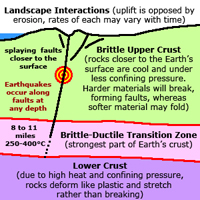 Fig. 6-31. The upper crust behaves in a brittle style, fracturing under strain (producing earthquakes), whereas at depth rocks deform plastically, folding or flowing under pressure rather than fracturing (no earthquakes). |
Phenomena Associated With Earthquakes and Convulsion Faults | |
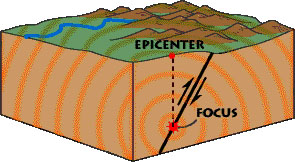 Fig. 6-32. Diagram illustrating the epicenter and focus of an earthquake forth a fault. | Terms used to depict earthquakes (illustrated in Figure vi-32):An earthquake is ground shaking caused by a sudden movement on a fault or by volcanic disturbance. An epicenter is the point on the Earth's surface above the point at depth in the Globe'due south crust where an earthquake begins. The focus is the point beneath the Earth'due south surface where seismic waves originate during an earthquake. |
Faults and Convulsion Faults
An earthquake fault is an agile error that has a history of producing earthquakes or is considered to have a potential of producing dissentious earthquakes on the ground of observable evidence. Not all faults are active or are considered earthquake faults. However, faults can remain dormant for long periods of time and tin can be reactivated by changing stress patterns in the chaff. Beneath are key terms used to describe convulsion phenomena. An earthquake is the sudden and sometimes violent shaking of the basis equally a event of movements within the chaff associated with fault rupture or volcanic activity. Earthquakes are described in terms of magnitude and intensity (discussed beneath). Earthquakes can also be a result of a landslide or an explosion (such every bit a mining or demolition nail, bomb testing, or potentially an asteroid bear on, or anything that creates a shockwave).Mistake creep
is the gradual movement (displacement) displayed by a error over time. Fault creep mostly keeps pace with regional plate-tectonic related move in a expanse. Creep is the aseismic movement of a mistake (motility without detectable earthquakes). Active earthquake faults can produce both earthquakes and pitter-patter. (Note that the discussion pitter-patter is also used for the deadening motion of soil downwardly a slope.) A rupture zone is the area through which fault movement occurred during an convulsion. For large earthquakes, the section of the fault that ruptured may exist several hundred miles in length. Note that ruptures associated with earthquakes may or may non extend to the ground surface. In addition, shockwaves produced by one earthquake fault, may also set off earthquakes on other faults. Seismic WavesSeismic waves are shock waves and vibrations in the Earth which issue from the focus of an earthquake—it may be a upshot of an earthquake, impact, or explosion, or some other process that imparts depression-frequency acoustic energy (Effigy 6-33).A P wave (P) is a compressional moving ridge is a seismic body moving ridge that shakes the ground dorsum and forth in the aforementioned management and the reverse direction as the direction the wave is moving. A P wave is the first daze wave to arrive from an earthquake at a distant location. A S wave (S) is a shear wave is a seismic torso wave that shakes the ground dorsum and forth perpendicular to the direction the moving ridge is moving. A seismograph is a device used to record earthquake shaking and are used to determine the altitude, magnitude and intensity of earthquakes. Information from numerous seismographs linked together in networks are used to make up one's mind the focus, epicenter, extent of rupture, and amount of shaking in a region caused by an earthquake. A minimum of 3 seismographs are needed to decide the epicenter of an convulsion (Figure half dozen-34). Today there are many thousands of seismographs connected to networks that tin can record earthquake information from effectually the world.A person who studies earthquakes and earthquakes faults is called a seismologist. Speed of P waves and S waves are used to determine the location of an earthquakeP waves ( principal compression shock waves) move nigh 4 miles per second (5 to 8 km/2d) depending on the density and grapheme of crustal rocks. (The actual range is between iii to 5 miles per 2nd or 5 to 8 km/2d). Southward waves ( secondary shear or shake waves) move most 60% as fast equally P waves in the aforementioned crustal rocks. Considering compression (P) waves travel faster than shear (S) waves: Using a precision clock and three seismographs, the location of an earthquake epicenter tin be precisely located past measuring the arrival times of the kickoff P wave and the first Southward wave (illustrated in Effigy half-dozen-34). Example: Suppose you lot feel an earthquake'southward P and South waves arrive 5 second apart. Assuming P waves moving at 5 miles per second and Southward waves moving 3 miles per 2nd (sixty% of the P wave), the epicenter of the earthquake was x miles away [calculation: (v mi/sec - 3 mi/sec) ten 5 sec = x miles]. | 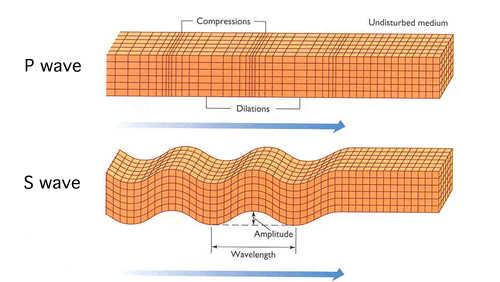 Fig. half dozen-33. Earthquake waves include: P waves (compression wave) and Southward waves (shear waves0 P-waves move faster than South-waves and are first to be felt, the Southward-waves go far next and produce the bulk of shaking in an earthquake. |
Convulsion Foreshocks, Aftershocks, and Principal EventsEarthquakes can exist complex events. An earthquake may be described as a single shock moving ridge or a complex pattern of stupor waves taking place over a menstruum of time. Typically in large earthquakes, there is a master event associated with the largest shock wave and significant rupture, but there there may exist a series of foreshocks and aftershocks created as the error rupture propagates through the crust, releasing or dispersing energy. Information technology is like to when a rock hits a windshield on a motorcar. the initial bang causes the upshot, but the cracks propagate beyond the window, releasing the pressure in the drinking glass as it shatters. Former small earthquakes happen earlier a main convulsion event—these are chosen foreshocks. More than typically, there are often numerous smaller magnitude earthquakes afterwards a main shock outcome—these are called aftershocks. Unfortunately, it is impossible to truly ascertain a foreshock before a larger-calibration earthquake. Both foreshocks and aftershocks can take place from seconds, minutes, hours, days, weeks, years, and fifty-fifty longer periods associated with a chief earthquake event.Can nosotros tell if an earthquake is a foreshock to a larger impending earthquake? The answer is a definite " maybe ." Some earthquakes exercise not have foreshocks. The seismic history of the major faults in some regions are well known. Faults, like the San Andreas Fault, are defined every bit segments based on earthquake history, boulder geology, and associations with intersecting faults (Figure 6-35). For example, some segments of the San Andreas Fault have experienced major earthquakes, releasing pent-upwardly pressure on a segment or segments of the fault. Some segments of the fault are creeping and are not likely to produce not bad earthquakes as in other segments (in theory). All the same other segments of the mistake are locked up and accept non experienced a major earthquake in historic times. It is these locked up segments that are of significant business concern, and any small convulsion or series of small earthquakes in the vicinity of these segments are considered possible foreshocks to a perhaps larger main shock and possible aftershocks to follow. | 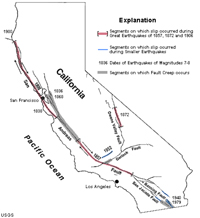 Fig. 6-35. The San Andreas Fault and other faults in the California Error System are subdivided into many segments based on seismic history, local geology, and intersections with other faults. |
Earthquake Magnitude and Earthquake IntensityThe energy released by earthquakes are measured or described in two ways: convulsion magnitude and earthquake intensity (Figure half-dozen-36).Earthquake magnitude (M) is a numeric measure that represents the size or strength of an earthquake, as determined from seismographic observations. The Richter scale is a numerical (logarithmic) scale for expressing the magnitude of an earthquake on the ground of seismograph oscillations data. Today convulsion intensity is recorded with a moment magnitude scale (MMS) which is based on the seismic moment of the convulsion, which is equal to the rigidity of the Globe multiplied past the average corporeality of slip on the fault and the size of the area that slipped. Richter scale and moment magnitude scales are similar, but the MMS scale is more than precise.Earthquake intensity (I) is a measure of ground shaking describing the local severity of an convulsion in terms of its effects on the Earth's surface and on humans and their structures. The Modified Mercalli Intensity (MMI) scale, which uses Roman numerals, is one way scientists describe convulsion intensity (see Figure six-36). | 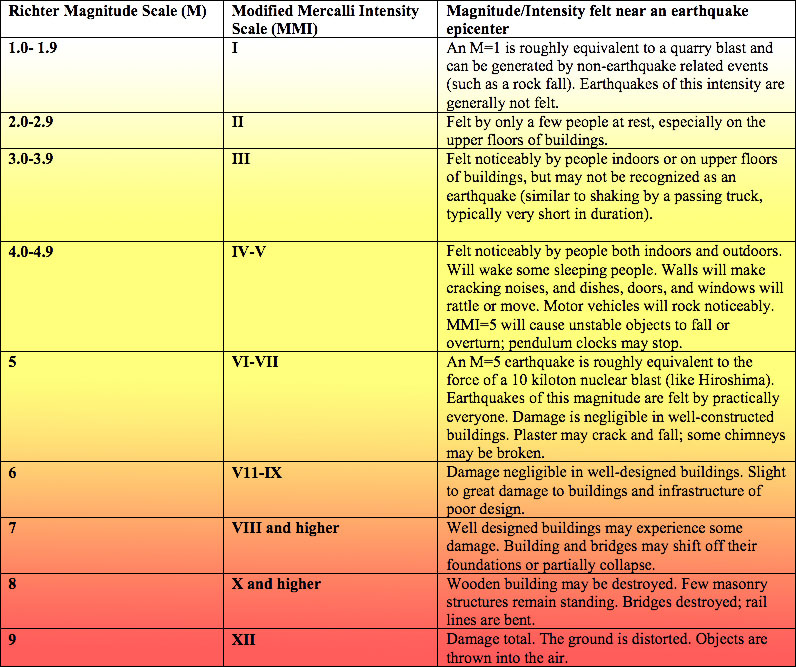 Fig. 6-36. Comparing of earthquake magnitude (MMS) and intensity (MMI) scales (USGS). |
Naming of Pregnant Earthquakes
Large, damaging earthquakes are typically named for a well-known named location or region nearly or effectually the epicenter of an convulsion and the year that it occurred. For example, the Great San Francisco Earthquake of 1906 or the Cracking Midwest Convulsion of 1811. The addition of the word not bad to a proper noun implies dandy destruction was associated with an historically massive earthquake (which, actually, isn't all that smashing!). Typically the maximum magnitude of the convulsion is also reported with earthquakes if the maximum magnitude was accurately/precisely adamant, such as the M9.2 Great Alaska Earthquake of 1964. Interestingly, the name Groovy San Francisco Earthquake was applied to the 1868 earthquake on the Hayward Fault, just the name was switched to the even greater 1906 convulsion on the San Andreas Fault. Neither error runs through San Francisco, merely that is where the destruction occurred.Seismic Networks
The US Geological Survey manages a national seismic network to collect earthquake data. This network is a collaboration with many organizations and universities involved in seismic inquiry.The USGS maintains office of the Global Seismographic Network which consists of thousands of seismographs around the world, so information about earthquakes tin exist calculated quite precisely. Below are examples of earthquake fault maps and earthquake hazard assessment maps of portions of the Us.
Selected Maps Illustrating Fault and Earthquake Data Figure six-37 is a map of faults in the San Francisco Bay region showing the location epicenters of historic earthquakes of varying intensity. Note that epicenters are not always on mapped mistake lines because the focus of earthquakes occur on faults below the surfaces. |
Check out these map posters for earthquakes and faults in southern and northern California!Sleeter, B.K., Calzia, J.P., and Walter, South.R., 2012, Earthquakes and faults in southern California (1970–2010): U.Southward. Geological Survey Scientific Investigations Map 3222, scale 1:450,000. (Bachelor at https://pubs.usgs.gov/sim/3222/.)Sleeter, B.Yard., Calzia, J.P., and Walter, S.R., Wong, F. L. and Sausedo, G.J., 2004, Earthquakes and faults in the San Francisco Bay Area (1970-2003): U.S. Geological Survey Scientific Investigations Map 2848, calibration 1:450,000. (Available at https://pubs.usgs.gov/sim/2848/.) |
Landscape Features Associated With FaultsThere are a wide variety of mural features (small to very large) associated with faults. Fault movements and weathering and erosion processes combine to create a multifariousness of landscape feature. It the long run, erosion tends to dominate and destroy or cover evidence of activity associated with fault movement, but often the location of faults can exist recognized by patterns on the landscape. Examples are described below: A graben is an elongate, structurally depressed crustal surface area or block of crust that is bounded by faults on its long sides. A graben may be geomorphically expressed as a rift valley or pull-apart basin. Grabens are usually associated with horsts (Figures 6-40 and 6-41).A horst is a raised elongated block of the earth's crust lying (or rise) between two faults. A rift valley is a valley that has formed along a tectonic rift. Rift valleys may be grabens or pull-apart basins, may be structurally complex, and are typically modified past erosion. The Cherry Sea is a flooded rift valley (similar to the African Rift valleys)(Figures half-dozen-42 and half-dozen-43). Rift valleys form as a result of crustal extension and may become divergent plate boundaries. |
Landscape Features Associated With High-Angle FaultsSeismically agile high-angle normal faults are numerous in the western U.s.a., especially in the Bully Basin and surrounding regions (Nevada, Utah, Idaho, Arizona, and eastern California). The Great Basin is undergoing crustal extension on a large scale (come across Figure 6-30). Crustal extension is creating massive block-faulted mountain ranges that by and large run north-south across the region. Massive normal faults run along many mountain fronts. Many of these range-front faults are considered earthquake faults. Their relatively young geologic age and their ongoing seismic activity results in the steep mountain fronts adjacent to sedimentary filled basins. Range-front faults adjoining many of the large mountain ranges are responsible for both dramatic scenery and significant earthquake risks! Examples include: the Wasatch Fault runs along the base of operations of the Wasatch Mountains between Ogden and Common salt Lake Metropolis, Utah (Figure 6-44); the Owens Valley Fault is responsible for the majestically steep mountain front end on the eastern side of the Sierra Nevada Mountains, California (Figure half-dozen-45); Grand Tetons National Park in Wyoming gets its dramatic scenery from the Tetons range-front error (Figures 6-46 and vi-47); Death Valley is on the eastern side of a range-front end fault on the western side of the Funeral Mountains, California (Figures 6-48 and six-49). |  Fig. 6-44. Map of the range-forepart fault line on the Wasatch Mountains, Ogden, Utah. | 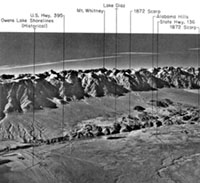 Fig. 6-45. Aerial view of the range-front fault in Owens Valley adjacent to the Eastern Sierra Nevada mount front. The fault produced the Owens Valley Earthquake of 1872 with an estimated magnitude of about half-dozen.8. |
Mural Features Associated With Strike-Slip Fault Zones (Common in California)California is famous for its active fault systems, many of the largest faults are strike-slip faults. Information technology is as well a dry out region, so surface features associated with convulsion fault motion tend to exist very well preserved and visible compared to features in wetter climates. Beneath are examples of landscape features associated with faults that display strike-skid offset (Figure half-dozen-50).A fault line is the trace of a fault plane intersects the footing surface or other surfaces, such every bit on a sea cliff, road cut, or in a mine shaft or tunnel. A mistake line is the same equally fault trace. Faults lines tin oftentimes be difficult to resolve from full general surface observation due to embrace by younger sediments, vegetation, and human-induced landscape modifications. They may be revealed by a color change in the soil, but other means are necessary to be sure information technology is a fault (geologists often dig trenches to study faults). Error lines are commonly associated with linear features on landscapes, just not all linear features are associated with faults. An escarpment is a long, more or less continuous cliff or relatively steep slope facing in i general direction, separating 2 level or gently sloping surfaces. Escarpments are produced both by faulting starting time or past erosion of cliff-forming stone bodies along river valleys. A sag pond is a natural depression associated with a fault or associated with a pull-apart basin along a error arrangement tin can hold h2o, even temporarily (case: Figure vi-52). A linear drainage is a stream drainage that follows the trace of a fault. Stream alignment may be a result of strike-slip fault motility. Streams tend to follow fault zones because the sheared and pulverized rock tend to be easily eroded compared to the surrounding solid boulder. A linear ridge is a long hill or crest of land that stretches in a directly line. It may indicate the presence of a fault or a fold (such as an anticline or syncline). If it is found along a strike-slip fault information technology may be a shutter ridge or a pressure ridge (example: Figures 6-53 and half dozen-54). A linear scarp is a directly escarpment where at that place is a vertical component of offset along a mistake (either normal or reverse). Linear scarps may likewise form when preferential erosion removes softer bedrock or soil along i side of a fault. An offset drainage is a stream that displays get-go by relatively recent move along a strike-slip mistake. A better term is deflected drainage. (case: Effigy 6-55). A side-loma benches is a step-similar surface on the side of a colina or mountain. Both recent mistake activity or erosional differences of boulder lithology across a fault may produce side-hill benches and associated linear scarps. Side-hill benches may also grade from slumping that may or may not be associated with faulting. Kickoff historic infrastructure reveals the location of major faults that are slowly creeping. Offset old fences, broken sidewalks and walls, cracks in old cement and asphalt are common along some of the creeping faults in central California; examples in Figures half dozen-56 and 6-57. |
Expressions of Fault Movement On Rocks In Fault ZonesError motion fractures, pulverizes, and crushes rock into fragments and powder. Mistake zones may be filled with crushed and broken rock through a broad area where large amounts of fault slip take taken place over millions of years. Where exposed by erosion or in cuts associated with construction, material impacted past crushing and shearing error motion has distinct characteristics:Slickensides are a polished and striated (scratched) rock surfaces produced past friction forth a mistake; they appear a scratches on a rock surface (example: Figure 6-58).Fault gouge is the mix of rock fragments and ground-up rock material in an fault zone; typically uncemented in active fault zones (example: Figure half-dozen-59). Mylonite is a fine-grained metamorphic stone, typically layered or banded, resulting from the grinding or burdensome of other rocks (case: Figure 6-sixty). Fault breccia is a mix broken stone fragments (athwart grains to massive blocks and boulders) found in a broad mistake zone (example: Figure 6-61). |
Finding And Interpreting FaultsTrenches are often dug across error zones to study how earthquakes take get-go layers of sediment. Figure 6-62 is an case of a trench profile recorded from a fault zone. Trench studies are conducted to possibly decide the frequency, intensity, and distributions of earthquakes in active fault zones over time, sometimes going dorsum hundreds to thousands of years. Trench studies tin can often reveal information about the frequency and possible intensity of earthquakes in the geologic past (including in prehistory —earlier records were kept about earthquake information and recorded, and before seismology became science about 100 years ago). Geologists use relative and absolute dating methods to try to interpret the earthquake history of faults. After a ground rupturing earthquake, sediment may be deposited over or next to the rupture. Those sediments may contain organic thing that can be dated past radiocarbon dating (C14/C12) methods or other ways. Data nerveless from trenches frequently reveal potential information about how often convulsion have occurred and sometime the intensity of by earthquakes. In young sediments, the offset caused by earthquakes may exist correlated to known strong earthquake in a region. Information from both celebrated and prehistoric earthquakes tin can assist determine how often earthquakes occur, and can be used to guess when a hereafter convulsion might happen, and the average frequency and intensity of past earthquakes. This information is used to predict earthquake risks and is an important component in convulsion take chances mitigation. | 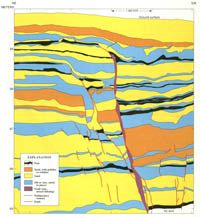 Fig. 6-62. Contour of layers of sediments exposed in a trench dug through a young fault. |
Notable Disasters Associated With Earthquakes And TsunamisEarthquakes have been the cause of many bang-up disasters throughout history. Effigy half dozen-62 is a list of the superlative 10 deadliest or most plush earthquakes. Earthquakes my be the cause of a disaster, just information technology is oftentimes fire, tsunamis, floods, or volcanic eruptions that may contribute to the death and destruction. |
What Causes Tsunamis?A tsunami is a very long and/or high sea moving ridge or coastal surge of water caused past an earthquake or other disturbance.Tsunamis are caused by displacement of the bedrock (seafloor) nether an ocean or body of h2o of any size. They can exist generated by earthquakes, volcanic explosions, or underwater landslides. When the solid globe moves, the h2o in a higher place it too moves with it. Tsunamis are the result of both the initial shock waves and the following move of the h2o readjusting to a stable pool (sea level). Tsunamis tin travel great distances throughout the world's bounding main. Their energy is dissipated when they approach shorelines where they come onshore as a great surge of h2o, with or without a massive waves crashing onshore (Figure 6-6-). Although most tsunamis are small (barely detectable), some modernistic tsunamis have reached inland elevations many hundreds of feet to a higher place body of water level. (Tsunamis are discussed in more detail in Chapter sixteen.) |  Fig. half-dozen-66. How seismic sea wave waves form by mistake displacement on the seafloor. Tsunamis can be caused by undersea earthquakes, volcanic eruptions, landslides, or impacts or explosions of any large size. |
Explosive Impact StructuresImpacts by about World asteroids (NEAs) of whatever size are exceedingly rare, from the 5-megaton limit of atmospheric shielding upwardly to the hundreds of millions of megatons associated with mass extinctions. Statistically, no touch on is to be expected within a human lifetime. (Let's hope that is truthful for ours!)"The most common estimate has been that the World is hit by a civilization threatening impact (past a 1.5-km-diameter asteroid) about twice per million years, which is equivalent to a 1-in-5000 chance per century." --from Asteroid and Comet Impact Gamble due south: NASA - http://impact.arc.nasa.gov/index.cfm). |
Faults, Convulsion Faults, and Earthquakes in SoCal (Southern California)Southern California is a very geologically active region. The maps below are very useful for understanding the nature of earthquake hazards in the region. Figure 6-72 shows the location of major historic earthquakes including regions where the major mistake displayed surface ruptures and the number of years between major ground-rupturing events where they've been studied in important locations.Figure 6-73 is a map showing SoCal's regional seismic activity as illustrated with the location of earthquake data recorded between the years of 1970 to 2010. Information technology is interesting to report this map to encounter which faults, or mistake systems were most agile within this time window. Faults that do not bear witness a lot of seismic action on this map may indicate three possible scenarios: 1) the mistake is no longer active, 2) the fault already experience an earthquake, and has released near of its stored up energy earlier 1970, or 3) the mistake is locked up and is potentially going to possibly create a major earthquake in the hereafter. It is interesting to study the mural geography (both topography and bathymetry) relative to the location of the faults on this map. In almost cases, the faults are associated with a mount front (both on land and offshore). Effigy half-dozen-74 shows a map of some of the major earthquake faults in Southern California, displaying characteristics of the faults beneath the surface. Faults shown as narrow lines are have a vertical orientation, whereas the wider lines show that the faults penetrate into the crust at a low angle (thrust faults). Many of the error show a component of both horizontal or vertical segments. Virtually all the faults are interconnected with other faults in the region. These maps show that the potential for major earthquake may occur both on country or offshore. The ones located offshore could peradventure generate massive tsunamis forth the SoCal coastline. |
6.30
Source: https://gotbooks.miracosta.edu/geology/chapter6.html

0 Response to "what features can be used to interpret which way a prehistoric fault moved?"
Post a Comment